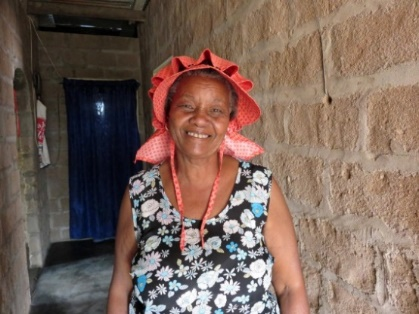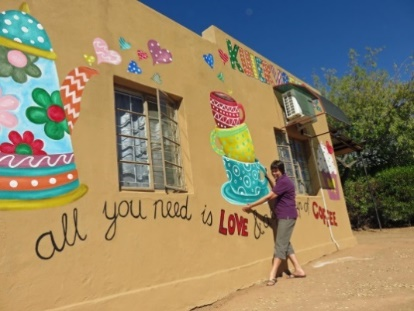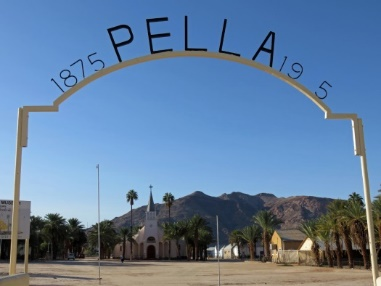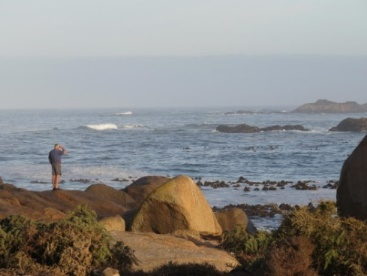When the afternoon traffic and the suburbs were behind me and signs indicated I was now travelling up the West Coast, I began to feel that exhilarating freedom of the open road strumming its soulful tune. It was time to open my window – wide - and glide into the spirit of the journey.



Tietiesbaai was lit up in gold as I approached the campsite. The evening was calm, shining and generous, boding an auspicious beginning to the trip. A singing sea, laughing children, the smell of wood smoke and the warm glow from a nearby caravan added to the benevolent light from the waxing moon and the sporadic beams from the Cape Columbine lighthouse. The lighthouse is said to be the first that visitors see if approaching the southern tip of Africa by ship. Closing my eyes to the last days of city-bustle, I drifted off into deep sleep to the sound of soothing sea lullabies.
When I checked out in the morning, I asked clerk Carmen Engelbrecht, about the origin of the name Tieitiesbaai. “Well, there is ‘Die Tiet’ of Tietiesbaai,” she told me “but there are similar rocks that also resemble ... umm ja, the real thing.”




Suitably informed and after discovering two new interesting and innovative West Coast breakfast options – a ‘gerookte mossel en kaas omelette’ at the rustic Seekombuis and a breakfast pizza at Blikkie Pizzeria, the Paternoster Hotel’s Panty Bar drew me in. As the story goes, the panty tradition began in 1974 when a honeymoon couple stayed at the hotel and the bride contributed a pair of panties. It grew into the theme for the pub. Today, the variety of multi-coloured panties that hang from the ceiling make for intriguing, if not puzzling, décor. Before continuing northwards – or losing any essential items of clothing, I made a stop at the beach where fishermen proffered their morning’s catch of crayfish and children selling shell-hearts vied for my attention.
As I hopscotched from place to place, skirting the glittering aqua-necklace of Verlorenvlei on my way to Lamberts Bay, an important aspect of travelling quietly dawned on me. It wasn’t just about the towns. Further on in the journey, Peet Kruger from Kuiersvreugde Coffee Shop in Kamieskroon would put it perfectly in perspective. “It’s about the people,” he told me. He was spot on, and it included everyone from the petrol attendants and waitresses to the ‘Roosterkoek koningin’ (Roosterkoek Queen) in Port Nolloth, who welcomed me into her humble home. And, everything they shared with me: good humour, a flash of white teeth, laughing crinkling eyes, a heartfelt handshake, words of wisdom, insights, life lessons or just plain friendliness. It was on the slow road that I had the opportunity to experience the warm heart of the Platteland.

On Bird Island at Lamberts Bay, Nature Conservation Assistant, Ashwell Schippers, spent time sharing what he finds special about the Cape Gannets while we watched the rowdy antics of the bustling bird colony. “When a bird returns from fishing, it will circle around the island until the partners identify each other with their unique call. After landing, they will perform a bill-scissoring ritual to strengthen their lifetime bond.” It seemed to me that we could learn a thing or two from these handsome seabirds.
Further north in Port Nolloth, I met Emma Seas, referred to as the Roosterkoek Koningin. Sister Em, a familiar face in the town, sets up her ‘Opelig kombuis’ (outdoor kitchen) in the lot behind the post office, selling boerewors roosterkoek, hamburger patties and potijiekos as she has done for the last eleven years. Using her initiative, she is supporting her late daughter’s children and has paid for her other daughter’s college education. Over the years her roosterkoek prices have increased from 50c to R5 apiece, keeping up with the times. Emma was invited to represent the Northern Cape at the 2015 Tourism Indaba and proudly showed me the banner especially made for her. She expressed her continual gratitude for the blessings in her life.
Before the cool sea air of Port Jolly sent me scurrying eastwards it was time to pay a visit to the museum on Beach Road (housed in one of the wood and corrugated iron buildings that were shipped in kit form from Denmark in the late 1800s) to say hello to George Moyses. One of the more colourful characters of the West Coast, George, an old diamond diver and long-time McDougall’s Bay resident, has a wealth of information about the area and keeps visitors entertained and enthralled with his stories. Before I left, he gave me some advice. “Don’t steal any diamonds!” Then he laughed and added as an afterthought that among the local people picking up diamonds was never considered stealing. “The locals say that the good Lord forgot to give them water but gave them plenty of diamonds instead.”




Pella, the century-old catholic mission, is easily reached after a short detour off the N14 before Pofadder (named after a Korana chief and not the lethargic reptile) and is a place that always fascinates me. Sister Rose was my affable host this time round and she light-heartedly joined in the children’s skipping game before opening up the lofty cathedral and describing the hardships the priests and brothers endured building it. “Their faith, perseverance, enthusiasm, love and commitment encourage me,” she told me. I looked around the old cathedral that still draws a Sunday crowd and asked her: “Do you think that God lent a helping hand?” “Of course,” she replied as we locked the door and walked out into the sunny Pella day.
The thundering waterfall and awe-inspiring viewpoints at Augrabies Falls National Park provided a heaped serving of natural splendour. Afterwards, I meandered through the nearby village looking for the home of Johanna Kock from the Namaratadi sewing project. The group of women make the Nama kappies (caps) worn on special occasions. Johanna told me to look at the label of one of her well-made kappies. As I turned it over, she read: ‘I make Nama kappies because I am proud of the Nama culture and traditions.’ A touch of the grace she radiated kept me company as I continued on my way to Kakamas and ‘Die Pienk Padstal’, home of lekker padkos, all things pink, rose quartz, quiver trees and good sayings. With the lights out for loadshedding, I struggled to read the origin of the name Kakamas on a small poster on the wall. Eventually I made it out: ‘Korana name Tkakamas. Two meanings are speculated: place of bad grazing fields or heavy tempered storming cow.’

This part of the journey ended at Keimoes, the crossing point where several roads meet and there is a choice of directions for onward travel: northwards to the Kgalagadi and Namibia, westwards to Springbok or southwards on the R27 towards Nieuwoudtville and Vanrhynsdorp or on the N10 to Beaufort West and the Karoo. It ended at a friend, as good journeys sometimes do. Maxi Compion, owner of De Werf Lodge and one of the initiators of the Kokerboom Food & Wine Route, had introduced to me to the area two years previously. We had soaked in the hot water spring of Riemvasmaak, followed the Nama bossie dokters through the Bushmanland veld and explored the region around the Orange River with its many river islands. I once again appreciated her optimism, enthusiasm for life and her well-used exclamation that liberally peppers her conversation: “Dis fantasies!” (It’s fantastic!)
As for the rest of the journey, well, David Kramer put it in a nutshell. It was somewhere between Port Nolloth and Pofadder that I had pushed his CD into the player and turned up the volume. He sang: ‘Die pad loop om en die pad loop aan.’ The road goes around and the road carries on.



De Werf Lodge, Keimoes +54 461 1635 dewerf@mweb.co.za www.dewerflodge.com
Dis Al selfsorg (self-catering) akkommodasie, McDougall’s Bay 081 371 6258 disal@telkomsa.net
Time well-spent:
Cape Columbine lighthouse, Cape Columbine Nature Reserve Mon-Fri 10-12 & 12.30-15.00 022 752 2705
Bird Island, Lamberts Bay (as many of the birds leave for the winter, the best time to visit is between September and March) Summer (1 Oct to 31 March) Mon-Sun 7.00-19.00, Winter (1 April-30 Sept) Mon-Sun 7.30-18.00 071 657 5651
The Rooibos Teahouse, Clanwilliam: Taste some of the 100 rooibos flavours 027 482 1007 www.rooibosteahouse.co.za
Bouldering at Rocklands on the Pakhuis Pass
The Sevilla Rock Art Trail (3 hours), Pakhuis Pass 027 482 1824
Port Nolloth museum Mon-Sun 9.00-16.00
Pella cathedral
Augrabies Falls National Park: Drive to the spectacular viewpoints in the game area, visit the falls or walk the short day trails 054 452 9200 www.sanparks.org/parks/augrabies/
Kokerboom Food & Wine Route Elmarie de Bruin 083 461 1724 www.openafrica.org/experiences/route/58-kokerboom-food-and-wine-route
Belly-fills:
Reuben’s Restaurant at Abalone House, Paternoster: for Reuben Riffel’s renowned cooking 022 752 2044
Muisbosskerm, 5km from Lambert’s Bay: open-air restaurant for a seafood buffet 027 432 1017
Isabella’s Restaurant, Lambert’s Bay: down-to-earth fare at the waterfront +27 432 1177
Yellow Aloe Coffee Shop, Clanwilliam: light meals in a garden setting 027 482 2018
Kuiervreugde Coffee Shop, Kamieskroon: a home café offering good coffee and ample platteland charm, as well as up-to-date information on the flowers 027 672 1904/072 141 8980
Traveller’s Rest, Pakhuis Pass: a relaxed and rustic farm stall for a light lunch 027 482 1824
Dis Al selfsorg (self-catering) akkommodasie, McDougall’s Bay 081 371 6258 disal@telkomsa.net
